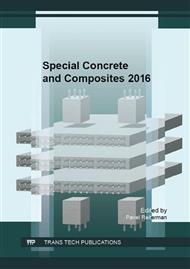[1]
S.R. Ferreira, Inverse identification of the bond behavior for jute fibers in cementatious matrix, Compos Part B Eng. 95 (2016) 440-452.
Google Scholar
[2]
J. Claramunt, L.J. Fernandez-Carrasco, H. Ventura, M. Ardanuy, Natural fiber nonwoven reinforced cement comnposites as sustainable materials for building envelopes, Construction and Building Materials. 115 (2016) 230-239.
DOI: 10.1016/j.conbuildmat.2016.04.044
Google Scholar
[3]
D.Y. Yoo, H.O. Shin, J.M. Yang, Y.S. Yoon, Material and bond properties of ultra high performance fiber reinforced concrete with microsteel fibers, Compos Part B Eng. 58 (2014) 122–133.
DOI: 10.1016/j.compositesb.2013.10.081
Google Scholar
[4]
E. Martinelli, A. Caggiano, H. Xargay, An experimental study on the post-cracking behaviour of hybrid industrial/recycled steel fibre-reinforced concrete, Constr Build Mater. 94 (2015) 290–298.
DOI: 10.1016/j.conbuildmat.2015.07.007
Google Scholar
[5]
F. Pacheco-Torgal, S. Jalali, Cementitious building materials reinforced with vegetable fibres: a review, Constr Build Mater. 25 (2011) 575–581.
DOI: 10.1016/j.conbuildmat.2010.07.024
Google Scholar
[6]
M. Ardanuy, J. Claramunt, R.D. Toledo Filho, Cellulosic fiber reinforced cement-based composites: a review of recent research, Constr Build Mater. 79 (2015) 115–128.
DOI: 10.1016/j.conbuildmat.2015.01.035
Google Scholar
[7]
G. H. D. Tonoli, S. F. Santos, H. Savastano, S. Delvasto, R. Mejía de Gutiérrez, M. D. M. Lopez de Murphy, Effects of natural weathering on microstructure and mineral composition of cementitious roofing tiles reinforced with fique fibre, Cem Concr Compos. 33 (2011).
DOI: 10.1016/j.cemconcomp.2010.10.013
Google Scholar
[8]
H. Savastano, S.F. Santos, M. Radonjic, W.O. Soboyejo, Fracture and fatigue of natural fiber-reinforced cementitious composites, Cem Concr Compos. 31 (2009) 232–43.
DOI: 10.1016/j.cemconcomp.2009.02.006
Google Scholar
[9]
H. Savastano, A. Turner, C. Mercer, W.O. Soboyejo, Mechanical behavior of cement-based materials reinforced with sisal fibers. J Mater Sci. 41 (2006) 6938–48.
DOI: 10.1007/s10853-006-0218-1
Google Scholar
[10]
H. Tonoli, G.H. Joaquim, A. Arsèneb,. M.A. Bilba, Jr.K. Savastano, Performance and durability of cement based composites reinforced with refined sisal pulp, Mater Manuf Process. 22 (2007) 149–56.
DOI: 10.1080/10426910601062065
Google Scholar
[11]
R.D. Tolêdo-Filho, K. Ghavami, G.L. England, K. Scrivener, Development of vegetable fibre-mortar composites of improved durability, Cem Concr Compos. 25 (2003) 185–96.
DOI: 10.1016/s0958-9465(02)00018-5
Google Scholar
[12]
R.D. Tolêdo Filho, K. Scrivener, G.L. England, K. Ghavami, Durability of alkalisensitive sisal and coconut fibres in cement mortar composites, Cem Concr Compos. 22(2000) 127–43.
DOI: 10.1016/s0958-9465(99)00039-6
Google Scholar
[13]
H. Savastano, P.G. Warden PG, R.S.P. Coutts RSP, Microstructure and mechanical properties of waste fibre–cement composites, Cem Concr Compos, 27 (2005) 583–92.
DOI: 10.1016/j.cemconcomp.2004.09.009
Google Scholar
[14]
H.S. Jr, P. Warden, R. Coutts, Ground iron blast furnace slag as a matrix for cellulose-cement materials, Cem Concr Compos, 23 (2001) 389–97.
DOI: 10.1016/s0958-9465(00)00083-4
Google Scholar
[15]
G.H.D. Tonoli, H. Savastano, E. Fuente, C. Negro, A. Blanco, Rocco Lahr Fa, Eucalyptus pulp fibres as alternative reinforcement to engineered cementbased composites, Ind Crops Prod. 31 (2010) 225–32.
DOI: 10.1016/j.indcrop.2009.10.009
Google Scholar


